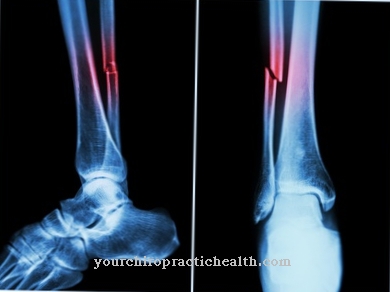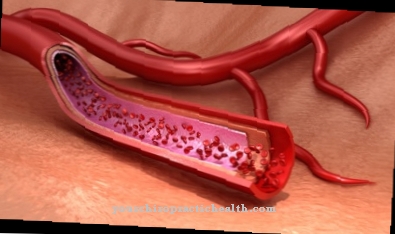The medulla oblongata and the pons are the circulatory centers of the brain and constantly receive information on blood pressure and gas composition. From here, measures for circulatory regulation may also be initiated, which is called central circulatory regulation is known. The system is disturbed in cardiovascular diseases.
What is the central circulatory regulation?

The blood circulation corresponds to a flow system and at the same time to the path that the blood travels from the heart in the cardiovascular system. The flow system of the blood circulation consists on the one hand of the heart and on the other hand of the blood vessels. Blood vessels supplying the heart are called veins. The draining vessels are called arteries. Blood vessels are more branched and smaller the further they are from the heart.
Regardless of the environmental and load-dependent conditions, the body must maintain the blood supply to the individual tissues and organs at all times. Vital oxygen reaches the tissues with the blood. The heart's actions and blood pressure are permanently regulated so that every organ in the body is supplied with a minimum of oxygen and blood. This regulation is guaranteed by various mechanisms. One of them is the central circulatory regulation.
This circulatory regulation occurs in the medulla oblongata and pons. The circulatory system has various sensors that permanently transmit information about the current circulatory situation to these areas of the brain. The information is evaluated in the areas mentioned and regulatory measures are taken if necessary.
Function & task
The wall of the aorta and the walls of the internal carotid artery are equipped with mechanoreceptors that detect stretching and pressure stimuli. These receptors are also located in the carotid sinus, the vena cava, and the atria. The sensory cells are baroreceptors. Arterial baroreceptors are high pressure baroreceptors. Venous baroreceptors are located in the low pressure system of the vena cava. By registering stretching, they continuously detect blood pressure. They convert this information into action potentials and translate it into a language that the central nervous system can process.
In addition to the blood pressure information from the baroreceptors, determined gas partial pressures or the pH value also play a role in central circulatory regulation. This information is also determined by receptors. Sensory cells with this task are called chemoreceptors and are mainly located in the paraganglia of the carotid artery, aorta and pulmonary artery. Together with the information from the baroreceptors, the chemoreceptors also reach the circulatory center of the posterior brain (medulla oblongata).
The information from the chemoreceptors gives the medulla oblangata information about the current gas composition and the oxygen content of the blood. If the oxygen content falls below the physiologically intended level, the afterbrain initiates counter-regulatory measures that relate primarily to breathing.
Regulatory countermeasures based on blood pressure information only take place in the brain after acute changes in blood pressure. Such acute changes are part of everyday life and await people, for example, when lying down or standing up from a lying position. In these situations the blood changes position rapidly due to gravity and is in danger of becoming boggy.
Central circulatory regulation does not therefore relate to slow changes in blood pressure that are kept constant after they occur. For example, if the blood pressure is constantly at a higher or lower level, the organism adapts to the new level. After the adjustment, the new blood pressure is kept constant.
Illnesses & ailments
Diseases with disorders of the central circulatory regulation mostly affect the heart or blood vessels. The heart is the motor in the bloodstream and keeps the blood moving by pumping it. A disturbed heart function can not only cause circulatory problems, but also result in organic damage. If the circulatory regulation is disturbed by heart disease, too little oxygen or blood may reach the tissues of the organs. This connection can be responsible for heart-related organ damage.
With all cardiovascular diseases, complaints can arise with the central circulatory regulation. These diseases are a large group of diseases and include, for example, angina pectoris, arteriosclerosis, chronic high blood pressure, diabetes, cardiac arrhythmias or strokes.
Most cardiovascular diseases are favored by stress, medication, smoking, a sedentary lifestyle and poor diet. Atherosclerosis in particular is now a relatively common disease. The disease corresponds to the deposition of fats, connective tissue or calcium in the blood vessels. The exact causes of arteriosclerosis have not been conclusively clarified. A starting point for the disease appears to be dysfunction or damage to the endothelium. As a result of the damage, LDL molecules reach the subendothelial layers in the tunica intima. This promotes oxidative processes that cause inflammatory reactions and the formation of plaques. Strokes, heart attacks and kidney failure can all be complications.
Atherosclerosis is often asymptomatic in the first few years. However, the plaque gradually constricts the blood vessels and the vessel lumen decreases. With a severe constriction there is a risk of occlusions, which can cause functional impairment of the circulatory system or even a heart attack. In addition, the vessel walls can tear. The result is the formation of thrombi.
In people over 80 years of age, the disease is usually age-dependent. Family stresses were also documented for the development of the disease. Further risk factors are a lack of exercise, previous illnesses such as obesity and habits such as smoking. Hypercholesterolemia, diabetes mellitus or hypertension (high blood pressure) can just as easily lead to calcification of the vessels and thus, in addition to problems with central circulatory regulation, cause the secondary diseases mentioned.

.jpg)











.jpg)

.jpg)
.jpg)










